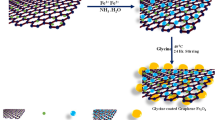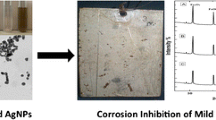Abstract
Steel is one of the mainly used materials in the oil and gas industry. However, it is susceptible to the marine corrosion, which 20% of the total marine corrosion is caused by microbiologically influenced corrosion (MIC). The economic and environmental impacts of corrosion are significant, and it is crucial to fight against corrosion in a proper sustainability context and environmental-friendly methods. In this study, the graphene oxide/silver nanostructure (GO-Ag) inhibitory effect on the corrosion of steel in the presence of sulfate reducing bacteria (SRB) was investigated, via weight loss (WL) and Tafel polarization measurements. Moreover, molecular dynamic (MD) simulations were performed to obtain a deep understanding of the corrosion inhibition effect of GO-Ag. GO-Ag showed a significant antibacterial effect at 80 ppm. Moreover, WL and Tafel polarization measurements illustrated a great inhibition efficiency, which reached up to 84% reduction of WL and 98% reduction of corrosion current density (Icorr) after 7 days of incubation with GO-Ag. Based on MD simulations, bonding energy reached to the larger value in the presence of GO-Ag, which indicated the ability of graphene oxide nanosheets to be adsorbed on the steel surface and prevent the access of corrosive agents to the steel surface. The radial distribution function (RDF) results implied distance between corrosive agent (water and SRB) and steel surface (Fe atoms), which indicated protection of the steel surface due to the effective adsorption of GO nanosheets through the active sites of the steel surface. The mean square displacement (MSD) result showed smaller displacement of the corrosive particles on the surface of steel, resulting that the GO-Ag molecules bonded with Fe molecules on the surface of steel.











Similar content being viewed by others
Data availability
The datasets used and/or analyzed during the current study are available from the corresponding author on reasonable request.
References
Allen MP (2004) Introduction to molecular dynamics simulation. Computational Soft Matter: from Synthetic Polymers to Proteins 23(1):1–28
Amin MA et al (2010) A study of the inhibition of iron corrosion in HCl solutions by some amino acids. Corros Sci 52:1684–1695. https://doi.org/10.1016/j.corsci.2010.01.019
Anandalakshmi K, Venugobal J, Ramasamy V (2016) Characterization of silver nanoparticles by green synthesis method using Pedalium murex leaf extract and their antibacterial activity. Appl Nanosci 6:399–408. https://doi.org/10.1007/s13204-015-0449-z
Api-l X et al (2013) Influence of sulfate reducing bacterial biofilm on corrosion behavior. Int Biodeterior Biodegradation 78:34–42. https://doi.org/10.1016/j.ibiod.2012.10.014
ASTM (2003) Standard practice for preparing, cleaning, and evaluating corrosion test specimens. In American Society for Testing and Materials 2003
Baffert C et al (2019) Hybrid cluster proteins in a photosynthetic microalga. FEBS J 287(4):721–735. https://doi.org/10.1111/febs.15025
Chafiq M et al. (2019) Synthesis and corrosion inhibition evaluation of a new Schiff base hydrazone for mild steel corrosion in HCl medium : electrochemical , DFT , and molecular dynamics simulations studies. J Adhes Sci Technol :1–32. https://doi.org/10.1080/01694243.2019.1707561
Eid MM, Duncan KE, Tanner RS (2018) A semi-continuous system for monitoring microbially influenced corrosion. J Microbiol Methods 150(May):55–60. https://doi.org/10.1016/j.mimet.2018.05.018
Enning D, Garrelfs J (2014) Corrosion of iron by sulfate-reducing bacteria: new views of an old problem. Appl Environ Microbiol 80(4):1226–1236. https://doi.org/10.1128/AEM.02848-13
Frentrup H et al (2015) In silico determination of gas permeabilities by non-equilibrium molecular dynamics: CO2 and He through PIM-1. Membranes 5(1):99–119. https://doi.org/10.3390/membranes5010099
Gordon O et al (2010) Silver coordination polymers for prevention of implant infection : thiol interaction, impact on respiratory chain enzymes, and hydroxyl radical induction. Antimicrob Agents Chemother 54(10):4208–4218. https://doi.org/10.1128/AAC.01830-09
Guan F et al (2017) Influence of sulfate-reducing bacteria on the corrosion behavior of 5052 aluminum alloy. Surf Coat Technol 316:171–179. https://doi.org/10.1016/j.surfcoat.2017.02.057
Hong S et al (2018) The maximum interbubble distance in relation to the radius of spherical stable nanobubble in liquid water: a molecular dynamics study. Fluid Phase Equilib 487:45–51. https://doi.org/10.1016/j.fluid.2019.01.014
Hsissou R et al (2020) Development and potential performance of prepolymer in corrosion inhibition for carbon steel in 0.1 M HCl : Outlooks from experimental and computational investigations. J Colloid Interface Sci 574:43–60. https://doi.org/10.1016/j.jcis.2020.04.022
Huttunen-Saarivirta E et al (2018) Ennoblement, corrosion, and biofouling in brackish seawater: comparison between six stainless steel grades. Bioelectrochemistry 120:27–42. https://doi.org/10.1016/j.bioelechem.2017.11.002
Iskandar BS (2012) Mechanisms of microbiologically influenced corrosion : a review centre for corrosion research, Department of Mechanical Engineering Universiti Teknologi PETRONAS , Department of Fundamental and Applied Science , Universiti Teknologi PETRONAS , 17(4):524–531
Johnson DC et al (2005) structure, function, and formation of biological iron-sulfur clusters. Annu Rev Biochem 74:247–281. https://doi.org/10.1146/annurev.biochem.74.082803.133518
Jung WK et al (2008) Antibacterial activity and mechanism of action of the silver ion in Staphylococcus aureus and Escherichia coli. Appl Environ Microbiol 74(7):2171–2178. https://doi.org/10.1128/AEM.02001-07
Kalajahi ST et al (2020) Green mitigation of microbial corrosion by copper nanoparticles doped carbon quantum dots nanohybrid. Environ Sci Poll Res 27:40537–40551. https://doi.org/10.1007/s11356-020-10043-4
Kalajahi ST et al (2021) Graphene oxide / silver nanostructure as a green anti - biofouling composite toward controlling the microbial corrosion. Inter J Environ Sci Technol 18:195–210. https://doi.org/10.1007/s13762-020-02846-2
Karimi E, Yazdian F, Rasekh B, Jeffryes C, Rashedi H, Sepahi AA, Shahmoradi S, Omidi M, Azizi M, Bidhendi ME, Hatamian A (2018) DBT desulfurization by decorating bacteria using modified carbon nanotube. Fuel 216:787–795. https://doi.org/10.1016/j.fuel.2017.10.030
Khezri A et al (2018) Molecular dynamic of curcumin/chitosan interaction using a computational molecular approach : emphasis on biofilm reduction. Inter J Biological Macromolecules 114:972–978. https://doi.org/10.1016/j.ijbiomac.2018.03.100
Khorrami S, Abdollahi Z, Eshaghi G, Khosravi A, Bidram E, Zarrabi A (2019) An improved method for fabrication of Ag-GO nanocomposite with controlled anti-cancer and anti-bacterial behavior; A comparative study. Sci Rep 9:1–10. https://doi.org/10.1038/s41598-019-45332-7
King M, Gee D (2010) Multiscale modeling of particle interactions: applications in biology and nanotechnology. John Wiley & Sons
Kumar R et al (2019) Functionalized graphene oxide as a new generation corrosion inhibitor for industrial pickling process : DFT and experimental approach. Mater Chem Phys 236:121727. https://doi.org/10.1016/j.matchemphys.2019.121727
Kurapati YA (2018) Molecular dynamics study to understand behavior of corrosion inhibitors in bulk aqueous phase and near metal-water interface (Doctoral dissertation, Ohio University)
Lgaz H et al (2020a) Exploring the potential role of pyrazoline derivatives in corrosion inhibition of mild steel in hydrochloric acid solution: insights from experimental and computational studies. Constr Build Mater 233:117320. https://doi.org/10.1016/j.conbuildmat.2019.117320
Lgaz H Salghi R Masroor S (2020b) Assessing corrosion inhibition characteristics of hydrazone derivatives on mild steel in HCl: insights from electronic-scale DFT and atomic-scale molecular dynamics. J Mol Liquids :112998. https://doi.org/10.1016/j.molliq.2020b.112998
Lin J, Ballim R (2012) Biocorrosion control: current strategies and promising alternatives. African J Biotechnol 11(91):15736–15747. https://doi.org/10.5897/AJB12.2479
Liu Y et al (2014) Fabrication of a superhydrophobic graphene surface with excellent mechanical abrasion and corrosion resistance on an aluminum alloy substrate. RSC Adv 4(85):45389–45396. https://doi.org/10.1039/C4RA06051B
Liu H et al (2018) Corrosion of antibacterial Cu-bearing 316L stainless steels in the presence of sulfate reducing bacteria. Corr Sci 132:46–55. https://doi.org/10.1016/j.corsci.2017.12.006
Loto CA (2017) Microbiological corrosion: mechanism, control and impact—a review. Inter J Adv Manufacturing Technol 92(9–12):4241–4252. https://doi.org/10.1007/s00170-017-0494-8
Ma X et al (2019) Sunflower head pectin with different molecular weights as promising green corrosion inhibitors of carbon steel in hydrochloric acid solution. ACS Omega 4(25):21148–21160. https://doi.org/10.1021/acsomega.9b02570
Magin CM, Cooper SP, Brennan AB (2010) Non-toxic antifouling strategies. Mater Today 13(4):36–44. https://doi.org/10.1016/S1369-7021(10)70058-4
Marciales A et al (2018) Mechanistic microbiologically influenced corrosion modeling—a review. Corr Sci 146:99–111. https://doi.org/10.1016/j.corsci.2018.10.004
Mofradnia SR et al (2018) Fe/starch nanoparticle - Pseudomonas aeruginosa: bio-physiochemical and MD studies. Inter J Biological Macromolecules 117:51–61. https://doi.org/10.1016/j.ijbiomac.2018.04.191
Mohammadnejad J, Yazdian F, Omidi M, Rostami AD, Rasekh B, Fathinia A (2018) Graphene oxide/silver nanohybrid: optimization, antibacterial activity and its impregnation on bacterial cellulose as a potential wound dressing based on GO-Ag nanocomposite-coated BC. Eng Life Sci 18:298–307. https://doi.org/10.1002/elsc.201700138
Monti S et al (2019) Structure and dynamics of gold nanoparticles decorated with chitosan-gentamicin conjugates: ReaxFF molecular dynamics simulations to disclose drug delivery. Phys Chem Chem Phys 21(24):13099–13108. https://doi.org/10.1039/c9cp02357g
Moraes AC, Lima BA, de Faria AF, Brocchi M, Alves OL (2015) Graphene oxide-silver nanocomposite as a promising biocidal agent against methicillin-resistant Staphylococcus aureus. Int J Nanomedicine 10:6847–6861. https://doi.org/10.2147/IJN.S90660
Morsi RE, Labena A, Khamis EA (2016) Core/shell (ZnO/polyacrylamide) nanocomposite: in-situ emulsion polymerization, corrosion inhibition, anti-microbial and anti-biofilm characteristics. J Taiwan Inst Chem Eng 63:512–522
Muthu M et al (2018) Hydrophobic bacteria-repellant graphene coatings from recycled pencil stubs. Arab J Sci Eng 43(1):241–249. https://doi.org/10.1007/s13369-017-2901-8
Narenkumar J, Parthipan P, Nanthini AU, Benelli G, Murugan K, Rajasekar A (2017) Ginger extract s green biocide to control microbial corrosion of mild steel. 3 Biotech 7:1–11. https://doi.org/10.1007/s13205-017-0783-9
Nwankwo HU, Olasunkanmi LO, Ebenso EE (2017) Experimental, quantum chemical and molecular dynamic simulations studies on the corrosion inhibition of mild steel by some carbazole derivatives. Sci Rep 7(1):1–18. https://doi.org/10.1038/s41598-017-02446-0
Obot IB, Haruna K, Saleh TA (2019) Atomistic simulation: a unique and powerful computational tool for corrosion inhibition research. Arabian J Sci Eng 44(1):1–32. https://doi.org/10.1007/s13369-018-3605-4
Parra C et al (2015) A nanomolecular approach to decrease adhesion of biofouling-producing bacteria to graphene-coated material. Journal of Nanobiotechnology 13(1):1–10. https://doi.org/10.1186/s12951-015-0137-x
Parra C et al. (2017) The many faces of graphene as protection barrier. performance under microbial corrosion and Ni allergy conditions. Materials, 10(12), 1406. https://doi.org/10.3390/ma10121406.
Poyet S et al (2017) Microstructure and diffusion coefficient of an old corrosion product layer and impact on steel rebar corrosion in carbonated concrete. Corr Sci 125:48–58. https://doi.org/10.1016/j.corsci.2017.06.002
Raj A, Dhandia N, Balani K (2020) Adhesin protein interaction of Staphylococcus aureus bacteria with various biomaterial surfaces. ACS Biomater Sci Eng 6(11):6161–6172
Rasheed PA et al (2019) Controlling the biocorrosion of sulfate-reducing bacteria (SRB) on carbon steel using ZnO/chitosan nanocomposite as an eco-friendly biocide. Corros Sci 148:397–406
Roma V et al (2002) Hybrid cluster proteins (HCPs) from Desulfovibrio desulfuricans ATCC 27774 and Desulfovibrio vulgaris ( Hildenborough ): X-ray structures resolution using synchrotron radiation. J Biol Inorg Chem 7(4–5):514–525. https://doi.org/10.1007/s00775-001-0326-y
Sabaghian S et al (2020) Investigating the effect of starch/Fe3O4 nanoparticles on biodesulfurization using molecular dynamic simulation. Environ Sci Pollut Res 27:1667–1676. https://doi.org/10.1007/s11356-019-06453-8
Sadekuzzaman M et al (2015) Current and recent advanced strategies for combating biofilms. Comprehensive Reviews in Food Science and Food Safety 14(4):491–509. https://doi.org/10.1111/1541-4337.12144
Safdari F et al (2017) DFT calculations and molecular dynamics simulation study on the adsorption of 5-fluorouracil anticancer drug on graphene oxide nanosheet as a drug delivery vehicle. J Inorganic Organometal Poly Mater 27(3):805–817. https://doi.org/10.1007/s10904-017-0525-9
Saha SK, Ghosh P, Hens A, Murmu NC, Banerjee P (2015) Density functional theory and molecular dynamics simulation study on corrosion inhibition performance of mild steel by mercapto-quinoline Schiff base corrosion inhibitor. Physica E 66:332–341. https://doi.org/10.1016/j.physe.2014.10.035
Sahebnazar Z et al (2018) Zero-valent iron nanoparticles assisted purification of rhamnolipid for oil recovery improvement from oily sludge. J Environ Chem Eng 6(1):917–922. https://doi.org/10.1016/j.jece.2017.11.043
Shao W et al (2015) Preparation, characterization, and antibacterial activity of silver nanoparticle-decorated graphene oxide nanocomposite. ACS Appl Mater Interfaces 7(12):6966–6973. https://doi.org/10.1021/acsami.5b00937
Sharma A, Sharma D, Verma SK (2018) In silico study of iron, zinc and copper binding proteins of Pseudomonas syringae pv. lapsa: emphasis on secreted metalloproteins. Front Microbiol 9: 1838
Tait WS (1994) An introduction to electrochemical corrosion testing for practicing engineers and scientists. PairODocs Publications
Taylor P et al (2007) Biofouling: The Journal of Bioadhesion and Biofilm A review of “ green ” strategies to prevent or mitigate microbiologically influenced corrosion influenced corrosion. Biofouling 23(2):87–97. https://doi.org/10.1080/08927010601151782
Wang M et al (2016) Adsorption characteristics of graphene oxide nanosheets on cement. RSC Adv 6(68):63365–63372
Wang J et al (2019) The performance and mechanism of bifunctional biocide sodium pyrithione against sulfate reducing bacteria in X80 carbon steel corrosion. Corr Sci 150:296–308. https://doi.org/10.1016/j.corsci.2019.01.037
Funding
The Iran National Science Foundation (INSF) under Grant 97007558 had a partial financial support to publish this article.
Author information
Authors and Affiliations
Contributions
All the authors contributed evenly.
Corresponding author
Ethics declarations
Ethics approval and consent to participate
Not applicable.
Consent for publication
Not applicable.
Competing interests
The authors declare no competing interests.
Additional information
Responsible Editor: Philippe Garrigues
Publisher's note
Springer Nature remains neutral with regard to jurisdictional claims in published maps and institutional affiliations.
Supplementary Information
Below is the link to the electronic supplementary material.
Rights and permissions
About this article
Cite this article
Kalajahi, S.T., Mofradnia, S.R., Yazdian, F. et al. Inhibition performances of graphene oxide/silver nanostructure for the microbial corrosion: molecular dynamic simulation study. Environ Sci Pollut Res 29, 49884–49897 (2022). https://doi.org/10.1007/s11356-022-19247-2
Received:
Accepted:
Published:
Issue Date:
DOI: https://doi.org/10.1007/s11356-022-19247-2




